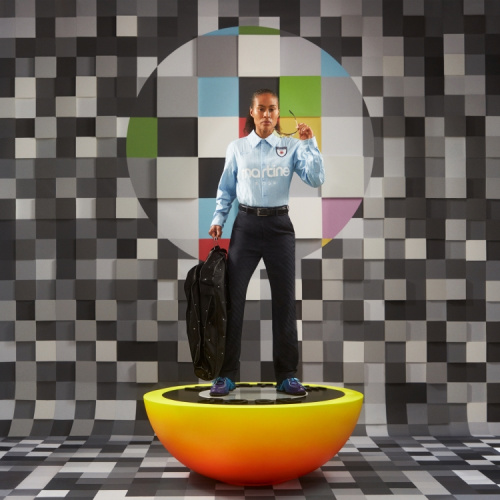FIFA Women’s World Cup 2023 by design
For the largest ever edition of the Women’s World Cup, we look at the design work behind the tournament, from the logo and kits to off-pitch fashion.
The largest ever FIFA Women’s World Cup 2023 has just begun, taking place across Australia and New Zealand and including 32 teams for the first time.
Spread across six football confederations, this year sees debuts from Haiti, Morocco, Panama, the Philippines, Portugal, the Republic of Ireland, Vietnam and Zambia.
The strategy for the tournament’s branding was based on the idea Beyond Greatness, which, according to FIFA secretary general Fatma Samoura, “perfectly captures where FIFA wants to take the female game in the hearts and minds of football fans worldwide”.
With renewed energy and investment in women’s football from both FIFA and brands, the prize money has also risen 300% since the 2019 tournament to make this year’s pot of $110 million (£84.1 million). However, this still sits at only a quarter of the $440 million (£336.4 million) awarded at the 2022 men’s World Cup in Qatar.

Much design work for the tournament draws on the two home nation’s history and culture – with a focus on indigenous Antipodeans and working with local creative talent.
Meanwhile, each of the women’s teams, many with their own distinct nicknames – including England’s Lionesses, Australia’s Matildas, China’s Steel Roses and Zambia’s Copper Queens – have newly designed kits, drawing on their nation’s culture and natural landscapes.
Branding
The identity was first revealed in 2021, designed by studios Public Address and Works Collective, working with local artists Chern’ee Sutton and Fiona Collins and local type designer Alistair McCready.
Eschewing the usual focus on the trophy, the logo is instead formed by 32 coloured squares, one for each of the participating teams, arranged in a circular formation around a football.
The squares’ arrangement is intended to represent a “coming together” of the world’s best, and the spirit of the host countries “radiating back out to the world”, according to the studios.
View this post on Instagram
Overlayed squares in different colours and patterns are used throughout the graphic language of the identity, additionally becoming frames for video during broadcast.
The local artists developed the patterns, Sutton designing those for Australia, inspired by Aboriginal tools or representing gatherings of people, and Collis designing New Zealand’s based on traditional weaving techniques.

The bespoke typeface was designed by New Zealand type designer and Monolith director Alistair McCready, with letterforms inspired by the squares.
The opening ceremony
View this post on Instagram
The opening ceremony featured Maori and First Nation vocal and dance performances, with large fabric puppets of a Stingray and Rainbow Serpent to represent the two host nations.
Additional groups of dancers wore costumes inspired by the 32 national jerseys.
As the ceremony came to a close, the performers held large fabric squares of colour held above their heads – recreating the logo in large-scale.
Match ball

The match ball, named OCEAUNZ, “to reflect the coming together of Australia and New Zealand”, features designs by both Sutton and Collis, inspired by the natural landscapes of their countries.
On the technical side, it features the same connected ball technology as seen in Qatar at the FIFA World Cup 2022, providing precise ball data to help with decisions.
Its polyurethane (PU) skin features a mix of textures, which, combined with its 20-piece panel shape, is designed to enhance aerodynamics.
The Trophy

The Trophy, which unusually does not feature in the 2023 identity, is the same in use since the third Women’s World Cup, held in the USA in 1999. It was designed by William Sawaya of the Milan firm Sawaya and Moroni.
It measures 47 centimetres and weighs in at 4.6 kilograms, made of sterling silver coated in 23-carat white and yellow gold. According to FIFA, its spiral design tries “to symbolise the athleticism, dynamism and elegance of women’s football”.
Kits
A design highlight of any World Cup, this year’s kits come from a range of brands, with 10 from Adidas, 13 from Nike, and others from Castore (Republic of Ireland), Grand Sport (Vietnam), Hummel (Denmark), KoPa (Zambia), Le Coq Sportif (South Africa), Puma (Switzerland) and Saeta (Haiti).
Building on an ongoing collaboration with the brand beyond football, fashion designer Grace Wales Bonner co-designed the Adidas kit for Jamaica, complete with crochet cuffs on the away jersey and black gold and green with a delicate pinstripe on the home jersey.

The Japan jersey, with pink and purple tones inspired by the sunrise over Mount Fuji, reportedly sold out ahead of the tournament’s start.
England’s kit, designed by Nike, features a typeface by Neville Brody, with a “stencil feel” and a “modular, shape-driven aesthetic”.

Beyond the shirts, brands have developed new technology, including leak-proof shorts, often in period-friendly colours.
Adidas has announced its “biggest ever women’s football kit bag”, which it says was developed with athletes on women’s specific innovations and a “catalogue of firsts”. This includes bespoke sports bras engineered in collaboration with “The Bra Professor”, Joanna Wakefield Scurr, from the University of Portsmouth, Adidas says.

Off the pitch, the fashion collaborations continue. Working with Nike, British fashion designer Martine Rose has created a collection of tailored player suiting for team’s official engagements, while Italian brand Prada is dressing China’s Steel Roses in black suits, white shirts and black loafers.
-
Post a comment





